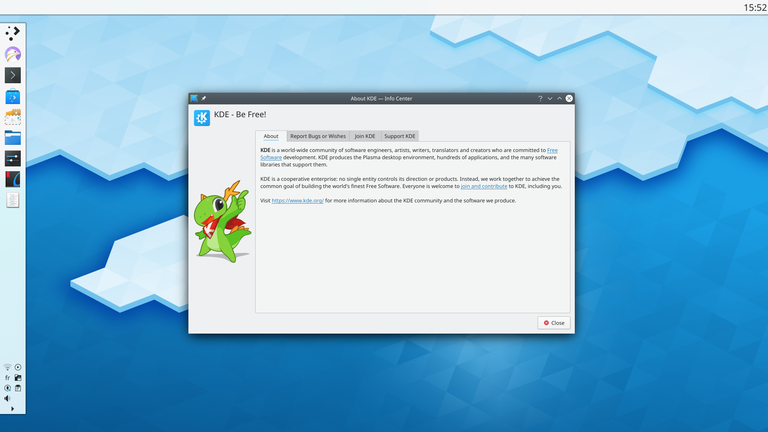Plasma/Panels/de: Difference between revisions
Created page with "Die Kontrollleiste ist ein Rahmen für Miniprogramme der an jeder Seite der Arbeitsfläche angebracht werden kann. Es können auch mehrere Leisten an einer Seite angebracht we..." |
Created page with "== Einstellungen ==" |
||
| Line 9: | Line 9: | ||
Falls Sie einen Laptop, ein Netbook oder einen anderen Rechner der eine Batterie verwendet benutzen, wird auch noch das [[Special:mylanguage/Plasma/Plasmoids#PowerDevil|"Akku und Bildschirmhelligkeits"-]] Miniprogramm im Systemabschnitt angezeigt. Ganz am rechten Rand der Leiste befindet sich ein Werkzeugkasten-Knopf. Über diesen kann das Einstellungsoptionen aufgerufen werden. | Falls Sie einen Laptop, ein Netbook oder einen anderen Rechner der eine Batterie verwendet benutzen, wird auch noch das [[Special:mylanguage/Plasma/Plasmoids#PowerDevil|"Akku und Bildschirmhelligkeits"-]] Miniprogramm im Systemabschnitt angezeigt. Ganz am rechten Rand der Leiste befindet sich ein Werkzeugkasten-Knopf. Über diesen kann das Einstellungsoptionen aufgerufen werden. | ||
== | == Einstellungen == | ||
The panel can then be configured by clicking on the toolbox located on the right for horizontal or bottom for vertical panel. At that point, the panel will be in configuration mode. Panel configuration may also be accessed via the context (right click) menu in the panel. | The panel can then be configured by clicking on the toolbox located on the right for horizontal or bottom for vertical panel. At that point, the panel will be in configuration mode. Panel configuration may also be accessed via the context (right click) menu in the panel. | ||
Revision as of 14:06, 18 April 2020
Kontrollleisten bei der Plasma-Arbeitsfläche

Die Kontrollleiste ist ein Rahmen für Miniprogramme der an jeder Seite der Arbeitsfläche angebracht werden kann. Es können auch mehrere Leisten an einer Seite angebracht werden. Die Standardeinstellung ist eine Kontrollleiste die sich über den gesamten unteren Rand der Arbeitsfläche erstreckt. In dieser Leiste befinden sich die folgenden Miniprogramme: der Anwendungsstarter, der Arbeitsflächen-Umschalter, die Prozessverwaltung (Liste der offenen Fenster), Systemabschnitt (enthält Sachen wie z. B. die Geräteüberwachung) und die Uhr. Falls Sie einen Laptop, ein Netbook oder einen anderen Rechner der eine Batterie verwendet benutzen, wird auch noch das "Akku und Bildschirmhelligkeits"- Miniprogramm im Systemabschnitt angezeigt. Ganz am rechten Rand der Leiste befindet sich ein Werkzeugkasten-Knopf. Über diesen kann das Einstellungsoptionen aufgerufen werden.
Einstellungen
The panel can then be configured by clicking on the toolbox located on the right for horizontal or bottom for vertical panel. At that point, the panel will be in configuration mode. Panel configuration may also be accessed via the context (right click) menu in the panel.

Widgets in the panel can be sorted by dragging them when in configuration mode. Widgets align left in the horizontal and top in the vertical panel
The Panel Toolbox
- : Locks the panel and widgets in position. Also hides the toolbox.
- : Removes the current panel and all widgets in it.
- : Allows you to drag the panel to any of the four edges of the screen.
- (for horizontal panel): Allows the panel height to be adjusted.
- (for vertical panel): Allows the panel width to be adjusted.
- : Allows widgets to be added to the panel.
- : Allows you to add a spacer into the panel giving space between the items in it.
- The standard behavior of a spacer is that it uses as much space as possible (flexible size), but you can also set it to a . Enter the context (right click) menu and deactivate .
The "More Settings" Menu
- : Allows the alignment of the panel to be set in three pre-set positions.
-
- : Keeps the panel visible at all times, even when windows are maximised.
- : Hides the panel off screen until the mouse is placed near the screen edge.
- : This allows windows to cover the panel and if maximised, will cover the panel.
- : This allows windows to go below the panel, even when maximised.
- : Makes the panel fit to the screen edges, if it has been resized.
Under the Hood
Should anything "untoward" happen to your panel have a look at ~/.config/plasma-org.kde.plasma.desktop-appletsrc - the panel itself is classed as a containment (there are at least two, the desktop and the panel) which is home to all the different widgets you put there.
Multiple Panels
It is also possible to have more than one panel on your desktop. This proves useful if you want to have a more flexible layout:

Adding a Panel
To add a new panel either click on the desktop toolbox button and select or open the context (right click) menu on the desktop and select from the menu.
If more than one kind of Panel is installed, you will be able to select between them to choose what sort of Panel you would prefer. By default, two Panel types are available: , which creates a Panel containing all of the default widgets (launcher, pager, tasks, system tray, clock, etc.), and , which adds an empty Panel without any pre-configured widgets in it.
Locking
The panels and desktop may be locked to prevent changes being made to them. When locked, the toolbox buttons will not be shown on either the desktop or on the panels. To configure a panel, it must be unlocked, otherwise the toolbox and context menu entries to configure or add widgets are unavailable.
Locking can be done by either selecting the entry in the Panel toolbox or in the Panel context (right click) menu. Once locked, the Panels can be unlocked again by right clicking on either a panel or desktop and selecting from the menu that is displayed.

